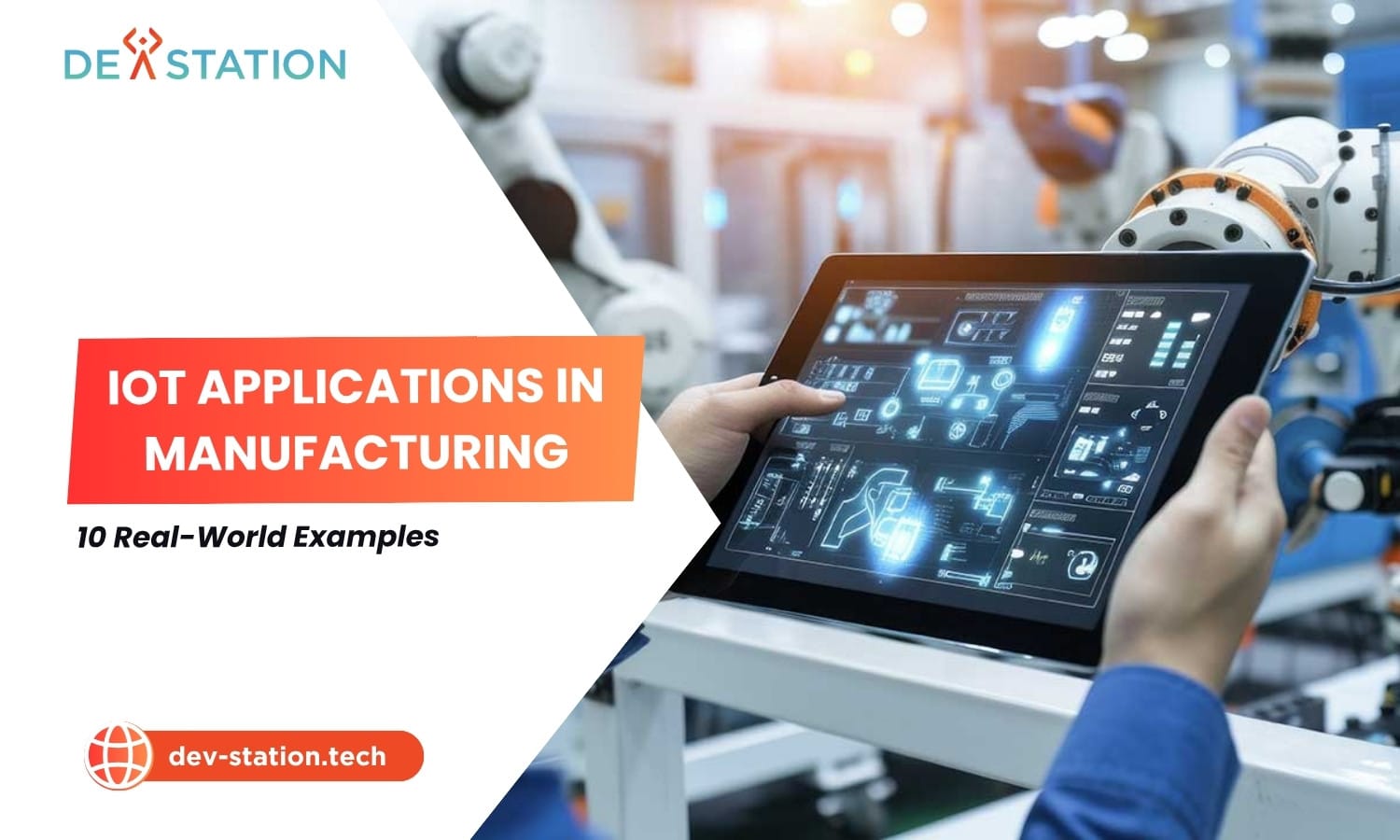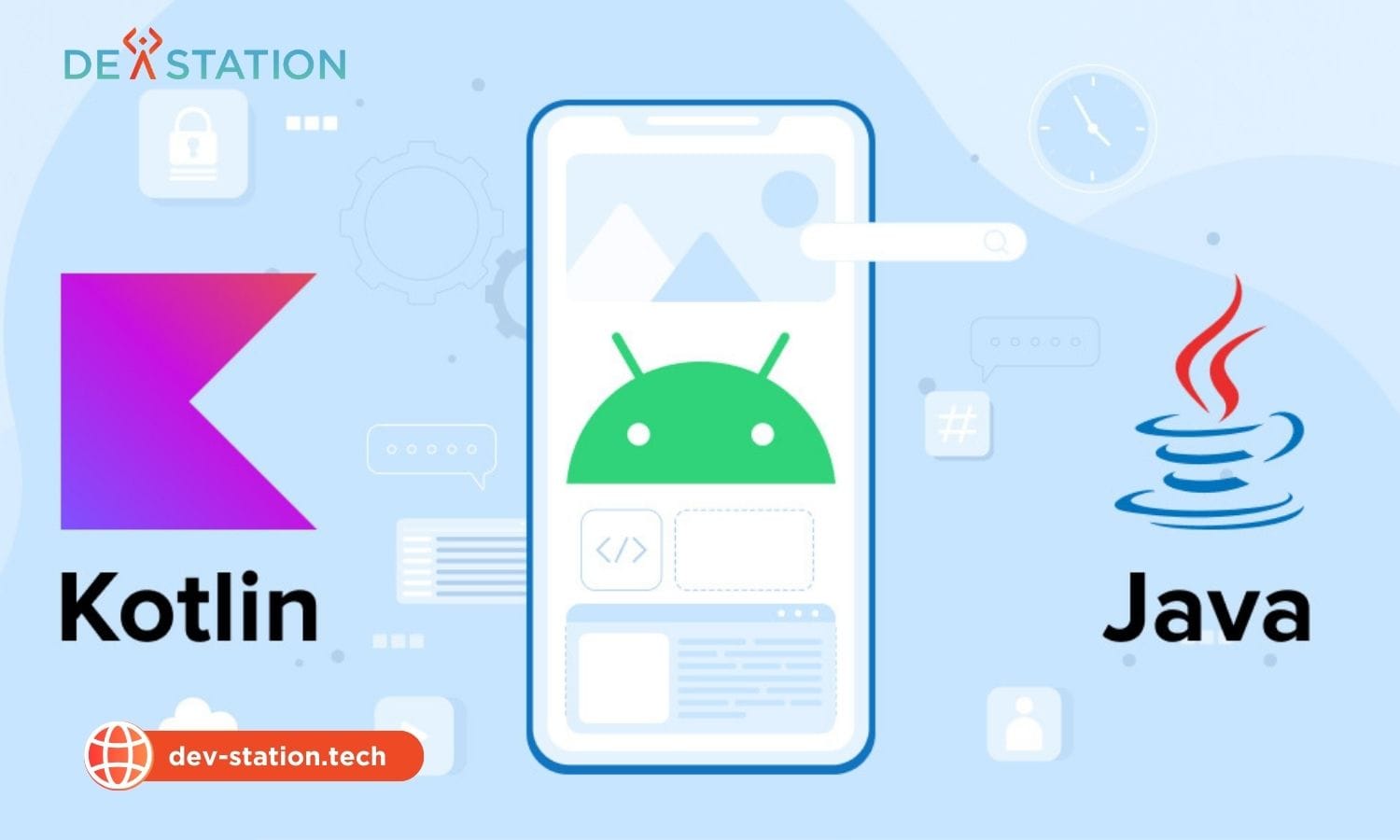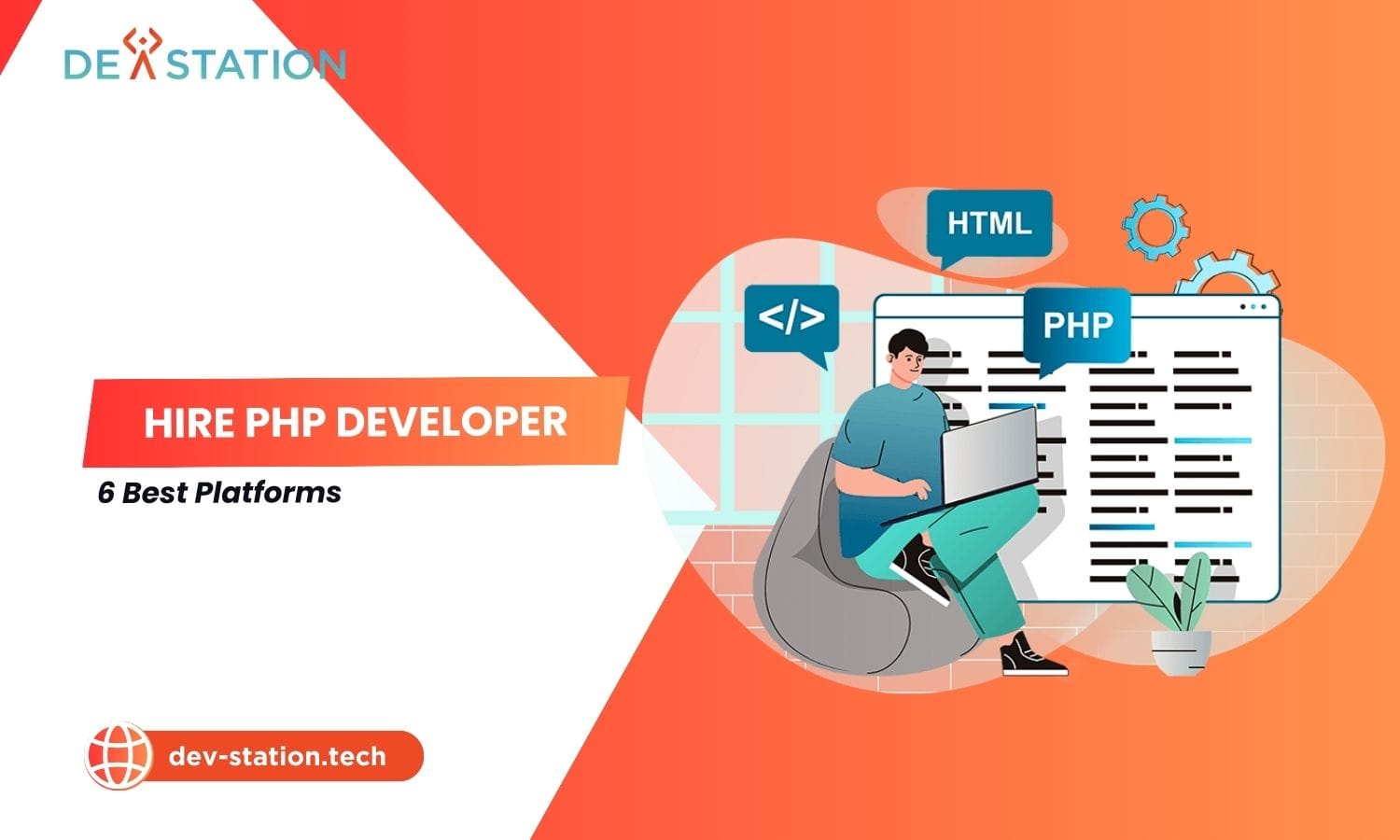IoT applications in manufacturing are transforming traditional factories into highly efficient, intelligent, and connected smart factory examples by providing unparalleled real-time data insights. The strategic implementation of these industrial internet of things solutions, a specialty at dev-station.tech, empowers businesses to optimize processes, enhance productivity, and unlock significant competitive advantages. This evolution in factory settings is pivotal for modern production, leading to enhanced operational technology and greater manufacturing efficiency.
Contents
ToggleWhat Are 10 Real-World IoT Applications in Manufacturing?
The top ten real-world IoT applications in manufacturing include predictive maintenance, AI-powered quality control, real-time production monitoring for OEE, digital twin simulation, supply chain visibility, energy management, asset tracking, inventory management, worker safety monitoring, and automated material handling. These IIoT applications drive efficiency, reduce costs, and create resilient operations.
The Industrial Internet of Things (IIoT) is no longer a futuristic concept; it is the driving force behind Industry 4.0, delivering tangible results on factory floors globally. By embedding sensors in machinery and connecting them to cloud platforms for advanced analytics, manufacturers are unlocking unprecedented levels of control and insight. Below, we explore ten of the most impactful IoT factory use cases that are reshaping the industry, complete with practical examples showing how these technologies deliver a strong return on investment.
- Predictive Maintenance (PdM)
- AI-Vision for Quality Control
- Real-Time Production Monitoring
- Digital Twin Technology
- Enhanced Supply Chain Visibility
- Smart Energy Management
- Intelligent Asset and Tool Tracking
- Automated Inventory Management
- Connected Worker Safety Solutions
- Automated Guided Vehicles (AGVs)
1. How Does IoT Enable Predictive Maintenance?
IoT enables predictive maintenance by using sensors to continuously collect real-time data on equipment health, such as vibration and temperature. This data is analyzed by machine learning algorithms to forecast potential failures, allowing maintenance to be scheduled proactively, which reduces unplanned downtime by up to 50%.
Predictive maintenance (PdM) represents a paradigm shift from traditional reactive (run-to-failure) and preventive (time-based) maintenance strategies. Instead of servicing equipment on a fixed schedule, predictive maintenance IoT systems use data to service equipment precisely when needed. This approach not only prevents unexpected breakdowns but also avoids unnecessary maintenance on healthy machinery.
Case Study: ThyssenKrupp
Global elevator manufacturer ThyssenKrupp implemented MAX, an IoT-based predictive maintenance solution. Sensors installed in their elevators collect data on everything from motor temperature to door mechanisms. This data is streamed to the Microsoft Azure cloud, where algorithms analyze it to predict component failures. The system has reportedly increased elevator availability by reducing downtime significantly. Technicians are dispatched with prior knowledge of the issue, improving first-time fix rates and overall efficiency.
2. How Does AI Vision Enhance Quality Control?
AI vision systems use IoT-connected cameras and machine learning algorithms to automate the visual inspection of products on the assembly line. These systems can identify microscopic defects, misalignments, or cosmetic flaws with greater speed and accuracy than human inspectors, often improving defect detection rates by over 90%.
Manual quality control is often a bottleneck in production, being both labor-intensive and susceptible to human error. The integration of AI vision quality control manufacturing systems offers a powerful solution. High-resolution cameras capture images of products as they move along the production line. These images are analyzed in real time by AI models trained to spot even the slightest deviation from quality standards. This is one of the most transformative Internet of things uses in production.
Case Study: BMW Group
At its factories, BMW uses an AI-based quality control system to inspect painted car bodies for imperfections like dust particles or surface irregularities. Cameras scan each vehicle, and an AI algorithm analyzes the images to identify and flag potential defects for review. This automated process is faster and more consistent than manual inspection, ensuring a higher quality finish on every vehicle and reducing the need for costly rework.
3. How Can Factories Use Real-Time Production Monitoring?
Factories use real-time production monitoring by connecting machines to an IoT platform that visualizes key performance indicators (KPIs) on live dashboards. This allows managers to track metrics like Overall Equipment Effectiveness (OEE), cycle times, and output, enabling them to identify bottlenecks and inefficiencies instantly.
Without real-time data, managers often rely on historical reports to make operational decisions, meaning problems are only addressed after they have caused significant delays or waste. With real-time production monitoring IoT solutions, data from PLCs, sensors, and other machine controllers is aggregated and displayed on intuitive dashboards. This provides a live, transparent view of the entire factory floor, helping to optimize smart manufacturing systems.
Case Study: A Leading Food & Beverage Company
A major bottling company implemented an IoT solution to track the OEE of its filling lines. Sensors on each machine monitored availability (uptime vs. downtime), performance (actual vs. ideal cycle time), and quality (good vs. rejected units). The real-time data revealed that minor stops, each lasting only a few seconds, were a major source of lost productivity. By addressing the root causes of these stops, the company increased its OEE by over 15% within six months, leading to millions in increased revenue without any new capital investment.
4. What Is a Digital Twin in a Manufacturing Context?
A digital twin in manufacturing is a virtual, dynamic replica of a physical asset, process, or entire factory. It is continuously updated with real-time data from IoT sensors, allowing companies to run simulations, test process changes, and predict outcomes in a virtual environment without risking physical operations.
The digital twin in manufacturing is one of the most advanced IIoT applications. It combines IoT data with physics-based models and machine learning to create a living simulation. This allows engineers to ask what-if questions, such as What happens if we increase the speed of this conveyor belt? or How will a different raw material affect this machine’s performance? The answers are provided by the digital twin, de-risking innovation and process optimization.
Case Study: Unilever
Unilever has been a pioneer in using digital twin technology across its factories. By creating virtual models of its production lines, the company can simulate changes to formulas, packaging, or line speeds. This allows them to optimize settings for new product launches before the physical line is ever touched, drastically reducing setup times and material waste. The digital twins are also fed with real-time data from IoT sensors, helping to identify performance deviations and their root causes quickly.
5. How Does IoT Improve Supply Chain Visibility?
IoT improves supply chain visibility by using GPS trackers and environmental sensors on shipments and assets. This provides real-time data on the location, condition (e.g., temperature, humidity), and estimated time of arrival of goods, enabling proactive management of logistics and inventory from end to end.
For manufacturers, the supply chain is a complex web of suppliers, logistics providers, and warehouses. A lack of visibility can lead to delays, stockouts, or damaged goods. The technology behind iot supply chain visibility manufacturing provides the real-time data needed to manage this complexity. Smart sensors can track not only location but also critical environmental conditions, which is essential for industries like food and pharmaceuticals.
Case Study: A Major Pharmaceutical Distributor
To comply with regulations and ensure product integrity, a pharmaceutical company equipped its temperature-sensitive shipments with IoT sensors. These sensors monitored the temperature of the products in real time throughout their journey. If the temperature deviated from the acceptable range, an alert was automatically sent to the logistics team, allowing them to intervene before the product was compromised. This system prevented millions of dollars in product loss and ensured patient safety.
6. Why is Smart Energy Management Important?
Smart energy management is important because energy is one of the largest operational costs in manufacturing. IoT solutions monitor energy consumption at a machine level, identify waste, and automate systems to reduce usage during non-productive times, leading to cost savings of 10-20% and a smaller carbon footprint.
Factories consume vast amounts of energy, and much of it is wasted by inefficient machinery or idle equipment. An iot energy management manufacturing system provides the granular data needed to tackle this waste. Smart meters and sensors are attached to individual machines or entire production lines to track consumption in real time. Analytics platforms can then identify anomalies, such as a machine drawing too much power, which often indicates a maintenance issue.
Case Study: ArcelorMittal
Steel manufacturer ArcelorMittal deployed an IoT-based energy management system to monitor the consumption of its high-energy furnaces and motors. By analyzing the real-time data, the company was able to identify opportunities to optimize operational parameters and shut down equipment during idle periods. The initiative resulted in a significant reduction in energy consumption, saving the company millions annually and helping it meet its sustainability goals. This is one of the most compelling industrial IoT case studies for ROI.
7. How Can IoT Help Track Assets and Tools?
IoT helps track assets and tools using low-energy tags (like Bluetooth or RFID) that broadcast their location. This allows workers to quickly find necessary equipment on a digital map, reducing search times, preventing loss or theft, and ensuring that tools are properly calibrated and maintained.
In large factories, a significant amount of time is wasted searching for tools, equipment, and movable assets. This lost time directly impacts productivity. IoT-based asset tracking provides a simple yet powerful solution. Small, inexpensive tags are attached to assets, and a network of receivers throughout the facility pinpoints their location in real time.
Case Study: An Aerospace Manufacturer
An aerospace company struggled with locating specialized tools required for aircraft assembly, sometimes leading to hours of delay. They implemented an RFID-based tracking system where each of the thousands of tools was tagged. Now, a technician can simply look up a tool’s location on a tablet, which displays its exact position on a factory map. The system has reduced tool search time by over 80% and improved production scheduling accuracy.
8. How Does IoT Automate Inventory Management?
IoT automates inventory management using smart shelves with weight sensors or RFID readers that track stock levels in real time. When inventory for a component drops below a predefined threshold, the system can automatically trigger a reorder request to the ERP system, preventing stockouts and manual counting.
Manual inventory counts are time-consuming and prone to errors, which can lead to production stoppages due to unexpected component shortages. IoT-powered inventory systems provide real-time, automated tracking. This ensures that the right materials are available at the right time, a core principle of just-in-time manufacturing.
Case Study: A Global Electronics Manufacturer
An electronics company uses smart bins equipped with weight sensors to manage its inventory of small components like resistors and capacitors. As components are used on the assembly line, the weight of the bin decreases. Once the weight falls below a certain level, the IoT platform automatically sends a replenishment order to the warehouse, ensuring the production line never runs out of critical parts. This has eliminated line-down situations caused by component shortages.
9. How Can IoT Solutions Improve Worker Safety?
IoT improves worker safety through wearable sensors that can monitor a worker’s location, detect falls, or sense exposure to hazardous materials. If a dangerous situation occurs, the system can send an automatic alert to supervisors, enabling a faster emergency response and preventing injuries.
Ensuring the safety of employees is the highest priority in any manufacturing environment. IoT wearables provide an intelligent safety net. These devices, which can be embedded in helmets, vests, or wristbands, are equipped with sensors like accelerometers, GPS, and gas detectors. They create a connected safety system that protects lone workers and those in hazardous environments.
Case Study: A Chemical Processing Plant
A chemical plant issued its workers with smart helmets equipped with gas sensors and an emergency button. The helmets monitor the air for toxic gases and sound an alarm if dangerous levels are detected. Additionally, if a worker falls and does not get up (detected by the accelerometer), the helmet automatically sends an alert with the worker’s exact location to the control room, significantly improving emergency response times.
10. What Is the Role of AGVs in Smart Factories?
Automated Guided Vehicles (AGVs) are robotic vehicles that use IoT connectivity and onboard sensors to transport materials around a factory without a human driver. They automate the movement of raw materials, work-in-progress, and finished goods, reducing labor costs and improving logistical efficiency.
The movement of materials is a constant, non-value-added activity in most factories. AGVs and their more advanced counterparts, Autonomous Mobile Robots (AMRs), use IoT to automate this process. They receive instructions wirelessly from a central fleet management system, which integrates with the factory’s Warehouse Management System (WMS) or Manufacturing Execution System (MES). These are key iot use cases for automation.
Case Study: Amazon Warehouses
Amazon’s fulfillment centers are a prime example of AGVs at scale. Fleets of robotic drive units move entire shelves of products to human pickers, who remain at their stations. This goods-to-person system dramatically reduces the time workers spend walking the warehouse floor, increasing picking speed and accuracy. The entire system is orchestrated by a sophisticated IoT platform that manages robot traffic and order fulfillment in real time.
How Do You Successfully Implement IoT in a Factory?
A successful IoT implementation follows a structured approach: start with a small, high-impact pilot project to prove value, define clear KPIs to measure success, choose a scalable and secure IoT platform, and plan for a phased rollout to scale the solution across the entire factory.
Adopting smart factory technology can seem daunting. A successful iot implementation in factory settings requires a clear strategy. At Dev Station Technology, we guide our clients through a proven four-step process for digital transformation.
- Start Small with a Proof of Concept (PoC): Identify a single, significant pain point. This could be a bottleneck machine or a critical quality control checkpoint. Implement a small-scale IoT solution to address this one problem. This allows you to demonstrate the ROI and gain buy-in from stakeholders with minimal risk.
- Define Clear Success Metrics: Before you begin, determine exactly what you want to achieve. Do you want to reduce downtime by 10%? Improve first-pass yield by 5%? Your KPIs should be specific, measurable, achievable, relevant, and time-bound (SMART).
- Choose a Scalable Architecture: Select an IoT platform and architecture that can grow with your needs. A solution that works for 10 sensors must also be able to work for 10,000. This involves planning for data storage, processing power, and network security from the outset.
- Plan a Phased Rollout: Once your PoC is successful, create a roadmap for scaling the solution. You might expand to all similar machines in one production line, then roll out to other lines, and finally connect different factory areas like the warehouse and quality lab. This incremental approach ensures a smooth and manageable adoption process.
How Can You Start Your Smart Factory Journey?
You can start your smart factory journey by partnering with an expert who can help you identify the highest-impact use cases for your specific operation. A consultation can provide a clear roadmap for a pilot project, outline the potential ROI, and guide you through the technology selection and implementation process.
The journey toward Industry 4.0 and the fully connected smart factory is a strategic imperative for manufacturers seeking to remain competitive. The IoT applications discussed here are not just theoretical possibilities; they are proven solutions delivering measurable value every day. From reducing operational costs to enhancing product quality and ensuring worker safety, the benefits are clear.
At Dev Station Technology, we specialize in helping manufacturing companies harness the power of IoT. We provide end-to-end solutions, from strategic consulting to the development and deployment of custom IoT platforms that address your unique challenges.
Ready to explore how these Internet of Things uses in production can transform your operations? We invite you to learn more about our successful IIoT case studies. Contact Dev Station Technology today to schedule a consultation and begin building your factory of the future. Visit us at dev-station.tech or email our team directly at sale@dev-station.tech to get started.





